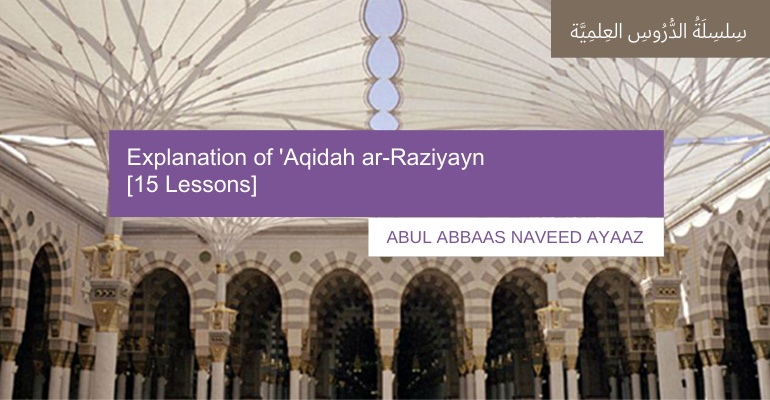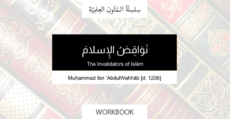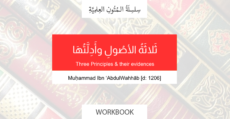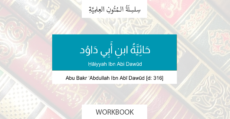- A series of lessons in explaining a concise yet comprehensive treatise in Aqeedah authored by the earliest Imams of hadith Abu Hatim ar-Razi (277h) and Abu Zur’ah ar-Razi (264h). In this treatise they narrate the Aqeedah of the early generations of the Muslims.
Lesson 1: Download Lesson 1
In this lesson, you will learn:
- Introduction to ‘Aqidah – Its meaning and importance;
- Historical reasons for deviation in ‘Aqidah;
- Names for ‘Aqidah in the books of the Salaf
Lesson 2: Download Lesson 2
In this lesson, you will learn:
- A reading of the whole text to provide context to the treatise, the whole text is read and translated with brief commentary.
Lesson 3:Download Lesson 3
In this lesson, you will learn:
- The correct belief regarding iman and proofs for it;
- Who were the Murjia and the sects within them;
- The justice of Ahlus Sunnah towards the people of innovation;
- who are Murjia al-Fuqaha;
- The different types of Kufr;
- The ruling of saying “I am a mu’min insha’Allah”.
Lesson 4: Download Lesson 4
In this lesson, you will learn:
- The correct belief with regards to the Qur’an and the speech of Allah;
- The attribute of voice;
- The stages of al-Qadr;
- Why evil is not ascribed to Allah and the falsehood of justifying sins using Qadr as a justification.
Lesson 5: Download Lesson 5
In this lesson, you will learn:
- The correct belief regarding the sahabah;
- The virtue of the Rightly Guided Caliphs,;
- Those who were given the glad tidings of Jannah;
- The belief of the Rafidha, who they are and why they were named Raafidha,
- Why we should not call them Shia;
- The correct stance towards the disputes which occurred between some of the sahabah.
Lesson 6: Download Lesson 6
In this lesson, you will learn:
- The correct belief regarding Allah being above his ‘Arsh;
- The different types of evidence to prove the elevated state of Allah;
- The description of the ‘Arsh and Kursi;
- The meaning of the two attributes of Allah: “al-Fawqiyyah” (Allah being above creation) and “al-Ma’iyyah” (Allah being with creation);
- A mention of some of the groups who deviated in this belief.
Lesson 7: Download Lesson 7
In this lesson, you will learn:
- The belief of Ahlus Sunnah regarding the believers seeing Allah in the Hereafter;
- The three matters which the groups of innovation agreed upon;
- The two types of sight the belief of the Mu’tazilah and Ash’arees with regards to seeing Allah;
- Will the Kuffar see and speak to Allah in the Day of Resurrection?
Lesson 8: Download Lesson 8
In this lesson, you will learn:
- The belief of Ahlus Sunnah regarding: Jannah (Paradise), Jahannam (Hellfire), Siraat (the bridge over the Fire) and the Qantara, Mizaan (the scales of justice) and Al-Haudh (the pond of the Prophet (sal Allaahu alayhi wa sallam) for the believers) and Al-Kawthar;
- The sequence of events on the Day of Resurrection.
Lesson 9: Download Lesson 9
In this lesson, you will learn:
- The belief of Ahlus Sunnah regarding: the intercession (shafa’ah) of the Prophet (sal Allaahu alayhi wa sallam);
- The punishment and questioning in the grave;
- Iman in the angels and the resurrection.
Lesson 10: Download Lesson 10
In this lesson, you will learn:
- The belief of Ahlus Sunnah regarding Muslims who commit major sins;
- Showing obedience to Muslim rulers even if they are corrupt;
- Why the Khawaarij and Mu’tazila deviated regarding this;
- The definition of “Kabair” (Major sins);
- The statement of Umar (radhiAllaahu anhu) regarding judging people’s intentions.
Lesson 11: Download Lesson 11
In this lesson, you will learn:
- The obligation upon a Muslim towards the Muslim rulers;
- How advice is given to a Muslim ruler;
- How a Muslim reacts to evil from a Muslim ruler;
- The importance of the pledge of allegiance;
- 9 principles regarding obedience to the Muslim ruler;
- The conditions of jihad;
- The intent behind the term “Ahlus Sunnah wal Jama’ah.
Lesson 12: Download Lesson 12
In this lesson, you will learn:
- Why a person cannot say “I am a true Mu’min”;
- It is not permitted to call somebody a martyr;
- What are the origins of the Jahmiyyah and Jahm Ibn Safwaan;
- The history of the Rafidhah and why they are given this name;
- Who are the Khawaarij, Qadariyyah and Mu’tazilah;
- Modern day examples of such sects
Lesson 13: Download Lesson 13
In this lesson, you will learn:
- A person who says “the Qur’an is created” has committed disbelief;
- The history and context of this deviation;
- General principles in understanding the names, attributes, descriptions and actions of Allah;
Lesson 14: Download Lesson 14
In this lesson, you will learn:
- One of the signs of Ahl Al-Bid’ah is insulting and mocking the scholars of Ahlus Sunnah;
- Examples of nicknames and insults used by the Zanadiqah, Jahmiyyah, Rafidhah and Qadariyyah against Ahlus Sunnah;
- Where does the name Zanadiqah come from and who are they?
- A warning against entering into disputes between the scholars or taking sides.
Lesson 15: Download Lesson 15
In this lesson, you will learn:
- Definitions of Bid’ah;
- The types and levels of Bid’ah;
- Where Bid’ah occurs;
- How to interact with an innovator;
- Guidelines with regards to boycotting an innovator







As-Salamu Alaykom wa Rahmatullahi Wa Barakatuh,
I think Lesson 14 got cut off? Jazakumu Lahu Khair.
Walaykum salaam wa rahmatullahi wa barakaatuh,
Unfortunately the recording was cut off wallaahu al-Must’an.
Assalam o Alaikum wrb shaykh. I run an elearning website (www.rgu-international.org) which provides free online courses. Can I share your lectures from our website. I would be very grateful for your kind consideration.
With salam,
Muhammad Nabeel Musharraf
Walaykum salaam wa rahmatullahi wa barakaatuh
May Allah bless you and your efforts – yes, all the material on the website can be used for free distribution.
Wa billahi at-Tawfeeq
Walaykum salaam wa rahmatullahi wa barakaatuh,
All the material on the website is free to be shared as long as no profit is being made nor is the content changed without permission.
Wa billaahi at-Tawfeeq.
May Allaah reward you abundantly